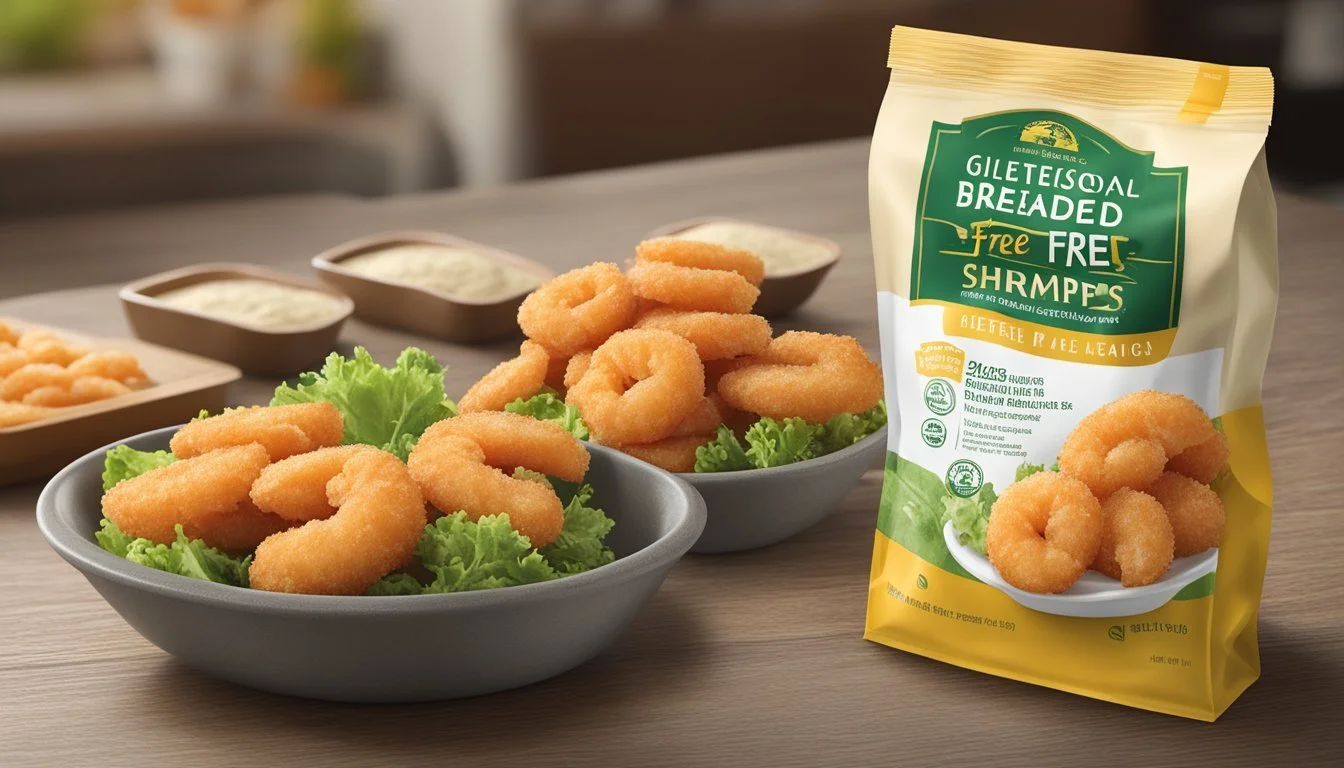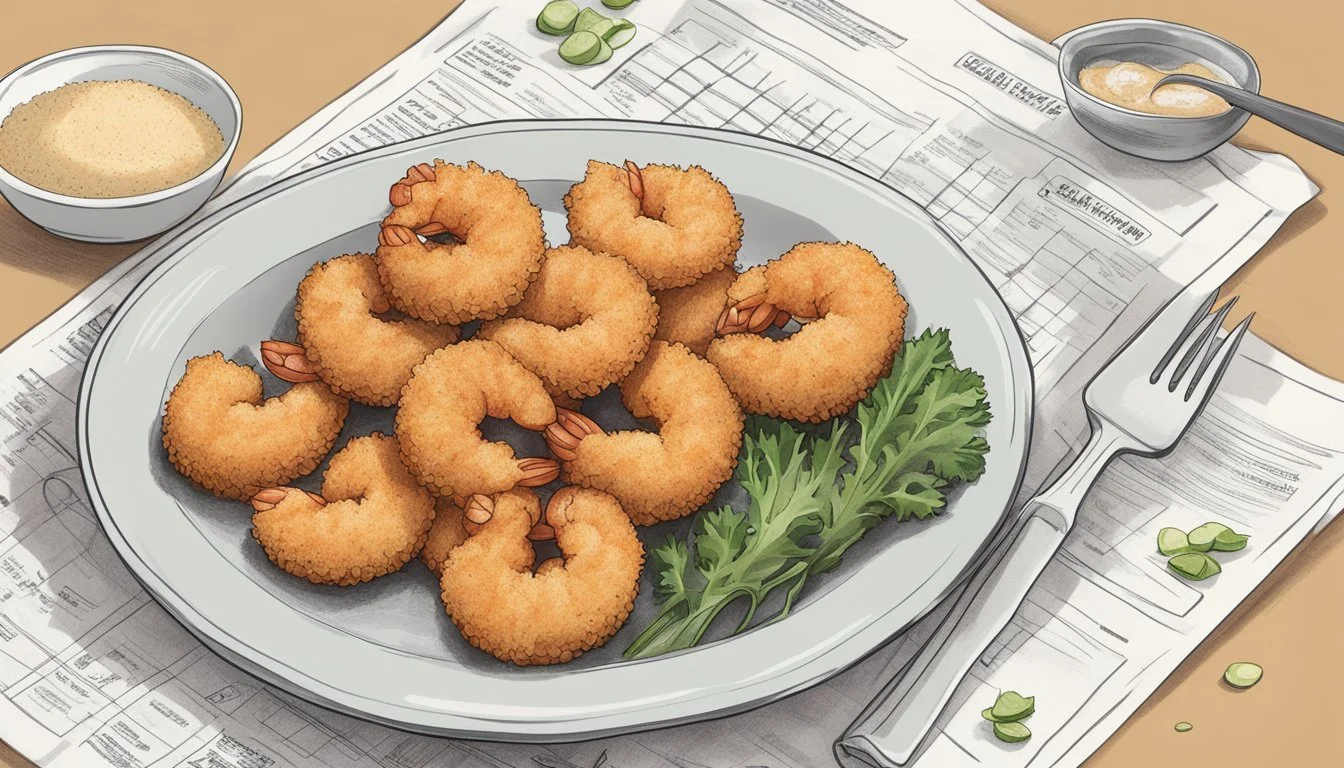How Long Does Gluten-Free Breaded Shrimp Last?
Storage Tips and Shelf Life
When it comes to preparing gluten-free breaded shrimp, many home cooks wonder how long they can safely store this delicious seafood dish. Gluten-free breaded shrimp typically lasts up to three days in the refrigerator if stored properly in an airtight container. This short shelf life is due to the perishable nature of seafood and the gluten-free breading that can become soggy over time.
For those who enjoy cooking and experimenting with gluten-free ingredients, it's essential to not only follow the recipe accurately but also pay attention to storage techniques. Storing your gluten-free breaded shrimp correctly can help maintain its texture and flavor, making it a tasty option for lunch or dinner within that timeframe. If you've made a larger batch and want to extend its lifespan, consider freezing the shrimp after breading but before frying, then cooking them as needed.
Ensuring the quality and safety of gluten-free breaded shrimp involves understanding both the preparation and preservation processes. When handling seafood, always prioritize freshness and proper storage to enjoy the best taste. With these considerations in mind, your gluten-free breaded shrimp can be a delightful part of your meal planning.
Understanding Gluten-Free Breaded Shrimp
Gluten-free breaded shrimp offers a safe and delicious option for those with gluten sensitivities. It's crucial to grasp both the benefits of gluten-free alternatives and the typical ingredients used for breading.
Definition and Benefits
Gluten-free breaded shrimp is a variant of traditional breaded shrimp, made without ingredients containing gluten, such as wheat flour. The main benefit of this dish is that it is safe for individuals with celiac disease or gluten intolerance.
Moreover, it often emphasizes healthier alternatives like tapioca starch, coconut flour, and rice flour. These substitutes are not just gluten-free but also add unique flavors and nutritional benefits. For instance, coconut flour is rich in fiber and healthy fats, making it a nutritious choice.
Common Ingredients in Gluten-Free Breading
Several ingredients are commonly used in gluten-free breading to achieve the desired texture and flavor. Tapioca starch is frequently used for its excellent binding properties. Coconut flour brings a mildly sweet flavor and a high fiber content.
Rice flour is another staple, offering a light and crispy texture. Seasonings like sea salt, onion powder, and garlic powder are typically added for flavor enhancement.
Each of these components contributes to a well-rounded gluten-free breading mixture, ensuring the shrimp remains flavorful and meets dietary restrictions.
Utilizing these ingredients allows for creative variations while maintaining the dish’s integrity as a gluten-free option.
Storage Fundamentals
To maximize the shelf life of gluten-free breaded shrimp, it's essential to understand the proper storage conditions and the shelf life considerations. These aspects ensure the shrimp remains safe to eat and maintains its quality.
Proper Storage Conditions
Gluten-free breaded shrimp should be stored at a consistent temperature to retain its quality and safety. Frozen shrimp must be kept in a freezer that maintains a constant temperature of 0°F (-18°C) or below. This storage method prevents bacterial growth and maintains the shrimp's texture and flavor.
If the packaging is opened, transfer the shrimp to an airtight container or freezer bag to minimize exposure to air and moisture. A good practice is to label the container with the date of storage. For maximum freshness, ensure that the shrimp does not go through repeated thawing and refreezing cycles as this can degrade the product.
Shelf Life Considerations
The shelf life of gluten-free breaded shrimp mainly depends on how well it is stored. Frozen shrimp can typically stay good for up to six months. It is important to check for any expiration dates or storage guidelines on the packaging, as these provided insights might vary by manufacturer.
In many cases, shrimp can be safe to consume for up to 9 to 12 months after the expiration date if properly stored. It's crucial to always inspect the shrimp for any signs of spoilage like off-odor or freezer burn before consuming. By adhering to these guidelines, the shrimp not only stays safe but also retains its optimal taste and texture.
Cooking and Reheating Techniques
Preparing gluten-free breaded shrimp involves a few key techniques, including baking, frying, and reheating. Each method ensures that the shrimp remains flavorful and crispy, prolonging its deliciousness.
Baking Instructions
To bake gluten-free breaded shrimp, preheat the oven to 350°F (175°C). Place the shrimp on a baking sheet lined with parchment paper. Arrange the shrimp in a single layer to ensure even cooking. Bake for 10-12 minutes, or until the shrimp is cooked through and the coating turns golden brown.
For an extra crispy texture, lightly spray the shrimp with cooking oil before baking. This helps to achieve a golden and crisp exterior. Be sure to flip the shrimp halfway through the baking time for even browning.
Alternative Cooking Methods
Air Fryer: Preheat the air fryer to 350°F (175°C). Place the shrimp in a single layer in the air fryer basket. Cook for 5-7 minutes, shaking the basket halfway through to ensure even cooking. The air fryer method is ideal for maintaining the shrimp’s crispiness without using too much oil.
Skillet Frying: Heat a few tablespoons of oil in a skillet over medium heat. Once hot, add the shrimp in a single layer. Fry for 3 minutes on each side until the shrimp is cooked through and the coating is crispy. Avoid overcrowding the pan to ensure each piece crisps evenly.
Reheating for Optimal Crispiness
Reheating gluten-free breaded shrimp can be done in a few ways to maintain its crispiness. Oven: Preheat to 350°F (175°C). Place the shrimp on a baking sheet and cook for 10-12 minutes. Air Fryer: Preheat to 375°F (190°C), place shrimp in the basket, and cook for 3-5 minutes, shaking midway.
Toaster ovens are another effective option. Place the shrimp on an aluminum foil-covered tray, set the toaster oven to 375°F (190°C), and heat for 7-10 minutes. Let the shrimp cool for a minute before serving.
Avoid microwaving if possible, as it can make the breading soggy.
Nutritional Information
Trader Joe's Gluten-Free Breaded Shrimp offers a range of nutrients, making it a versatile option for many meal plans. This section examines its caloric, macronutrient content, and levels of sodium and sugar.
Caloric and Macronutrient Content
A ⅓ package serving of Trader Joe's Gluten-Free Breaded Shrimp contains approximately 260 calories. This serving size weighs about 113 grams. The calorie intake is modest, fitting well into various dietary regimens.
Its macronutrient breakdown is as follows:
Carbohydrates: 23% of total calories
Fats: 64% of total calories
Protein: 12% of total calories
This product includes 16 grams of fat, contributing to a higher fat content. The protein content is moderate with 8 grams. Carbohydrates are relatively low at 15 grams. This profile suits those looking for a high-fat, moderate-protein diet.
Understanding Sodium and Sugar Levels
In the same ⅓ package serving, there are 480 milligrams of sodium.
This amount is significant but manageable within a balanced diet. Consumers should be aware of their overall daily sodium intake, particularly if they are on sodium-restricted diets.
This gluten-free breaded shrimp contains minimal sugar. There are no added sugars, making it suitable for those monitoring their sugar intake. This is beneficial for individuals with dietary guidelines focusing on reducing sugar consumption.
The shrimp also provides essential vitamins and minerals, including vitamin B12, phosphorus, and choline, contributing to overall nutritional value.
Special Dietary Considerations
When it comes to gluten-free breaded shrimp, it's important to consider compatibility with specific diets and potential allergens. Certain diets, like Whole30 and Paleo, have specific restrictions, and understanding these can help make informed choices.
Whole30 and Paleo Compatibility
Gluten-free breaded shrimp can be a great addition to both Whole30 and Paleo diets with certain modifications. For Whole30, ensure that the breading does not include any grains, sugars, dairy, or additives that are not compliant with Whole30 guidelines. Instead, use approved ingredients like almond flour, coconut flour, and compliant spices.
For Paleo followers, the key is to stick to natural, unprocessed ingredients. Breading should avoid grains and legumes, so options like almond flour or coconut flour are ideal choices. The shrimp itself fits well within Paleo parameters as long as it is prepared with approved ingredients.
Allergen Information
When preparing or purchasing gluten-free breaded shrimp, it's essential to be aware of common allergens. Besides gluten, other possible allergens include shellfish, eggs, and tree nuts.
Shellfish allergy means avoiding shrimp entirely. Gluten-free breading may still contain allergens like eggs, used in the coating process. Alternatives like flaxseed mixed with water can serve as an egg replacement.
Cross-contamination is also a concern. Ensure that all cooking utensils and surfaces are thoroughly cleaned to prevent exposure to allergens. Reading labels and confirming with manufacturers about potential cross-contamination can further safeguard against allergic reactions.
Brand and Product Reviews
Consumers have a variety of gluten-free breaded shrimp options, each with unique tastes and textures. This section covers popular choices, including insights on Trader Joe's and perspectives from social media.
Consumer Favorites
When exploring gluten-free breaded shrimp, certain brands consistently receive high marks from consumers. Popular brands often highlight their use of alternative flours like coconut or tapioca for breading.
Reviews frequently mention the importance of achieving a crispy texture and well-balanced flavor. Aqua Star is one noteworthy brand, known for offering 210 calories per six shrimp serving. Their products stand out for maintaining a good balance of protein and carbohydrates.
Trader Joe's Gluten-Free Breaded Shrimp
Trader Joe's offers gluten-free breaded shrimp priced under $10 for a 12-ounce bag. Their breading uses coconut flour and tapioca starch, ensuring a crispy texture that mimics traditional fried shrimp.
Consumer reviews often note the reasonable calorie count of 260 per serving, along with a high satisfaction rating for taste and texture. Trader Joe's has established a reputation for quality in the gluten-free segment, and these shrimp are no exception.
Gluten-Free Breaded Shrimp on Social Media
Social media platforms, particularly Instagram, are buzzing with reviews and photos of gluten-free breaded shrimp. Influencers and regular users alike share cooking tips and serving suggestions.
These posts often highlight creative ways to prepare the shrimp, using air fryers or ovens. Visuals of the crispy, golden shrimp are popular, and hashtags help spread the word about the best brands and products, with Trader Joe's frequently mentioned as a standout option.
Recipes and Serving Suggestions
Recipes for gluten-free breaded shrimp offer a variety of flavors and preparation methods. They blend essential ingredients like olive oil and eggs to create a crispy, buttery coating. Pairing these shrimp dishes with suitable accompaniments enhances the dining experience.
Homemade Gluten-Free Breaded Shrimp Recipe
Creating gluten-free breaded shrimp at home is straightforward. Begin by setting up a breading station with cornstarch, whisked eggs, and gluten-free breadcrumbs mixed with seasonings. Bread the shrimp in this order, ensuring each piece is well-coated.
For a crisp finish, cook the shrimp in an air fryer at 375°F for 10 minutes, flipping halfway through. Alternatively, frying the shrimp in olive oil heated to 350°F until golden brown works well. Aim for batches, with around five minutes per batch, to maintain the oil temperature.
Accompaniments and Pairings
Choose sides that complement the shrimp’s flavor. Steamed vegetables, such as broccoli or green beans, are light options that balance the rich shrimp. Rice pilaf or a quinoa salad can add a hearty component to the meal. For a dipping sauce, consider a blend of mayo, sweet chili sauce, and hot sauce for a tangy, spicy kick.
Serve with a squeeze of lemon for a bright, fresh finish. The combination of these elements, paired thoughtfully, creates a satisfying, complete meal.
Seasonal and Occasional Uses
Gluten-free breaded shrimp can be an excellent addition to various occasions, offering both flavor and a gluten-free option. Two notable settings for serving this dish include religious observances like Lent and social gatherings during the summer.
Lent and Religious Observances
During Lent, many Christians avoid meat on Fridays, making seafood a popular alternative. Gluten-free breaded shrimp fits perfectly into this tradition. The dish, prepared with gluten-free breadcrumbs, adheres to dietary restrictions while offering a tasty, protein-rich meal.
Additionally, the shrimp can be cooked in various ways, including baking, frying, or air frying, to suit different cooking preferences. Serving these shrimp with a side of fresh vegetables or a light salad can create a complete and balanced meal that aligns with Lenten practices.
Summer Gatherings and Barbecues
In the summer, gluten-free breaded shrimp can be an appealing addition to barbecues and outdoor gatherings. The shrimp cooks quickly on the grill, saving time and allowing more opportunities to enjoy the event. The gluten-free coating ensures guests with dietary restrictions can also savor the dish.
To enhance the experience, consider marinating the shrimp with citrus and herbs before grilling. Pairing the shrimp with grilled vegetables or incorporating them into kebabs can add variety to the menu.
Serving gluten-free breaded shrimp with dipping sauces, such as a tangy cocktail or a spicy aioli, can elevate the dish, making it a standout at any summer event.
After-Care Instructions
Handling gluten-free breaded shrimp requires specific after-care instructions to ensure kitchen cleanliness and appliance maintenance. Follow the tips below to keep your cooking area in top shape.
Proper Disposal and Clean-Up
After preparing gluten-free breaded shrimp, immediate disposal of waste materials is essential. Drain any leftover oil into a sealable container before discarding it. This prevents plumbing issues and maintains a clean kitchen environment.
Wipe down all counters and surfaces with a disinfectant to remove any remaining crumbs. Using a paper towel helps ensure thorough cleaning. Discard used paper towels in a trash bin lined with a disposable bag.
Tables such as these are useful:
Item Action Used Oil Seal in container and discard Cooking Utensils Wash and rinse Work Surfaces Wipe with disinfectant
Maintaining Kitchen Appliances
Regular maintenance of kitchen appliances used in preparing gluten-free breaded shrimp prolongs their lifespan and ensures food safety. Start with the stove or frying pan by wiping off any residue. Use a mild detergent and a non-abrasive scrub to avoid damaging surfaces.
Cleaning the oven thoroughly is critical as breadcrumbs may get trapped inside. For drains connected to kitchen sinks, run hot water mixed with a small amount of baking soda to clear any potential clogs caused by sticky or greasy substances.
Follow these key steps:
Turn off and unplug appliances before cleaning.
Disassemble removable parts for thorough washing.
Inspect for any damage or wear and replace parts if necessary.
Dry all components completely before reassembling.
By following these guidelines, the preparation and cleanup process becomes smoother, keeping the kitchen safe and functional.










